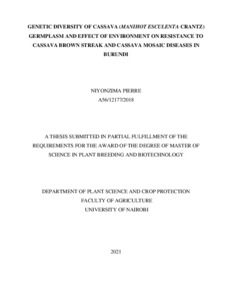| dc.contributor.author | Niyonzima, P. |
| dc.date.accessioned | 2022-06-27T09:07:57Z |
| dc.date.available | 2022-06-27T09:07:57Z |
| dc.date.issued | 2021 |
| dc.identifier.citation | Niyonzima, P. (2021). Genetic diversity of cassava (Manihot esculanta crantz) germplasm and effect of environment on resistance to Cassava Brown Streak and Cassava Mosaic Diseases in Burundi. Nairobi, Kenya: University of Nairobi, (112 p.). |
| dc.identifier.uri | https://hdl.handle.net/20.500.12478/7529 |
| dc.description.abstract | Cassava is an important cash crop for many small scale farmers in Burundi. Most small scale farmers use local landraces and though they have farmer preferred traits, their genetic diversity is unknown and marred by phenotypic susceptibility to Cassava Brown Streak Disease (CBSD) and Cassava Mosaic Disease (CMD). This limits future breeding programs to improve cassava production and resistance to diseases in Burundi. Due to this, disease tolerant genotypes from other countries were introduced to Burundi to help improve on their germplasm and then determine the relationships between local landraces and improved germplasm. Objectives of this study were to (1) assess the genetic diversity among cassava landraces and introduced cassava genotypes using morphological and molecular markers, (2) determine effects of genotype by environment (GxE) interaction on resistance to CBSD and CMD diseases in varied agro-ecological zones of Burundi. Genotype characterization was done using 17 qualitative agro morphological traits while molelcular analysis was conducted using SNP genotyping data from DaRTseq using KDCompute on 118 genotypes. For objective 2, the effect of GxE interaction on resistance to cassava viral diseases was determined using 18 accessions arranged in alpha lattice design on 9 blocks per site. Data was taken on sprouted cuttings, whiteflies population, foliar diseases, root necrosis, growth parameters and yield. Results for objective 1, on 118 accessions revealed more than 18,000 SNPs but there with low genetic distance (Fst<0.15) between local landraces and resistant genotypes. Phenotypic classification showed three main clusters based on Ward’s Method with cluster III containing all introduced genotypes; genotypic classification showed six main clusters with cluster II and IV having 5 and 11 introduced genotypes, respectively. Overall, 73 accessions had unique genotypes while 16 accessions were genetic clones indicating that 73 could be used in hybridization programs. Morphological markers showed five paired accessions using Ward’s method. According to the field experimental study, 3 genotypes had dual tolerance to CBSD and CMD on leaves; 5 genotypes were tolerant to CMD; 7 genotypes were tolerant to CBSD on leaves and stems while 2 genotypes were resistant. Overall, 8 clones showed high yield while 3 were tolerant to CMD and CBSD in all locations indicating that they could be used in breeding programs for germplasm improvement. In conclusion, results on molecular characterization will contribute to optimizing the conservation of genetic resources, together with understanding diversity and its use in crop improvement. Identification of resistant/ tolerant genotypes will be incorporated in cassava breeding program for transferring the genes to farmer-preferred varieties. Dually resistant genotypes like Mkumba and Pwani were identified as putative duplicates clones, might be used as genetic stock that could combine resistance to CBSD and CMD a single genotype. From this study, it is recommended that these cassava genotypes could be included in Burundi genetic improvement programs for higher yield to realize genetic gains with time. |
| dc.format.extent | 112 p. |
| dc.language.iso | en |
| dc.publisher | University of Nairobi |
| dc.subject | Cassava |
| dc.subject | Breeding |
| dc.subject | Germplasm |
| dc.subject | Genotypes |
| dc.subject | Morphological Diversity |
| dc.subject | Marker-Assisted Selection |
| dc.subject | Burundi |
| dc.subject | Central Africa |
| dc.title | Genetic diversity of cassava (Manihot esculanta crantz) germplasm and effect of environment on resistance to Cassava Brown Streak and Cassava Mosaic Diseases in Burundi |
| dc.type | Thesis |
| cg.contributor.crp | Roots, Tubers and Bananas |
| cg.contributor.affiliation | University of Nairobi |
| cg.contributor.affiliation | International Institute of Tropical Agriculture |
| cg.coverage.region | Africa |
| cg.coverage.region | East Africa |
| cg.coverage.country | Burundi |
| cg.coverage.hub | Eastern Africa Hub |
| cg.identifier.bibtexciteid | PIERRE:2021a |
| cg.authorship.types | CGIAR and developing country institute |
| cg.iitasubject | Agronomy |
| cg.iitasubject | Cassava |
| cg.iitasubject | Disease Control |
| cg.iitasubject | Food Security |
| cg.iitasubject | Genetic Improvement |
| cg.iitasubject | Plant Breeding |
| cg.iitasubject | Plant Diseases |
| cg.iitasubject | Plant Genetic Resources |
| cg.iitasubject | Plant Production |
| cg.iitasubject | Smallholder Farmers |
| cg.notes | IITA supervisor: Dr. Tumwegamire, S. |
| cg.publicationplace | Nairobi, Kenya |
| cg.accessibilitystatus | Limited Access |
| cg.reviewstatus | Internal Review |
| cg.usagerightslicense | Copyrighted; all rights reserved |
| cg.targetaudience | Scientists |
| cg.futureupdate.required | No |

